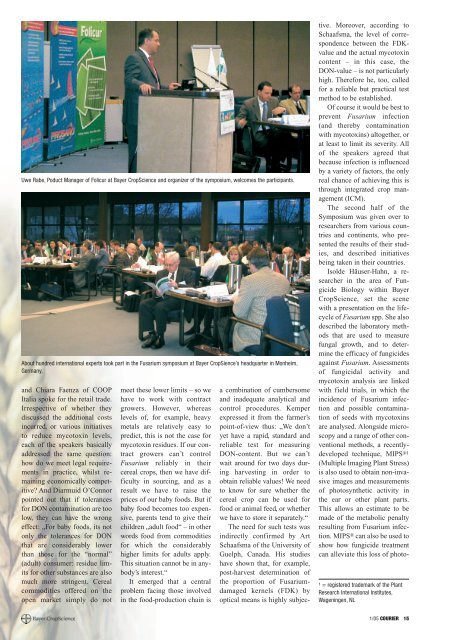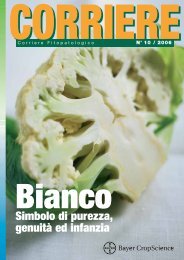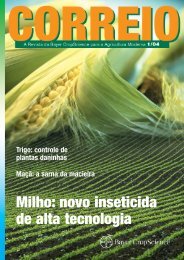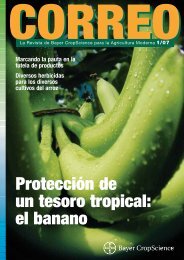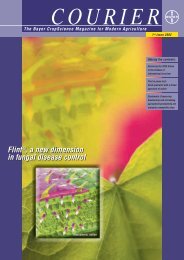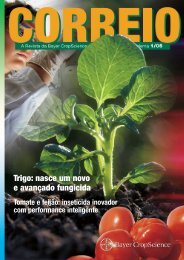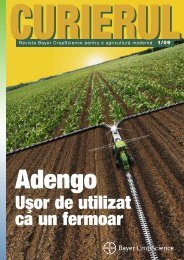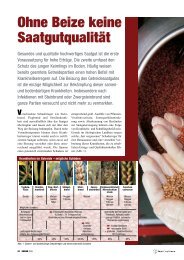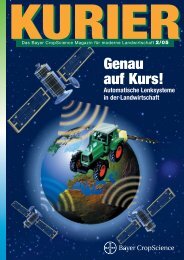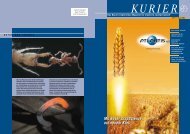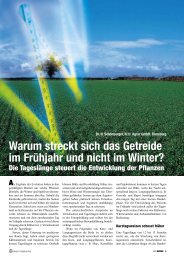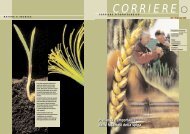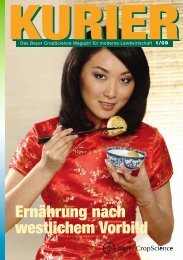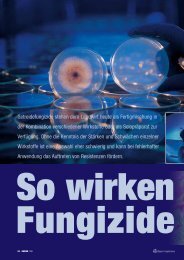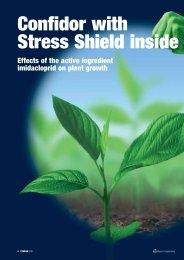Maize: the gift of the gods
Maize: the gift of the gods
Maize: the gift of the gods
- No tags were found...
You also want an ePaper? Increase the reach of your titles
YUMPU automatically turns print PDFs into web optimized ePapers that Google loves.
Uwe Rabe, Poduct Manager <strong>of</strong> Folicur at Bayer CropScience and organizer <strong>of</strong> <strong>the</strong> symposium, welcomes <strong>the</strong> participants.About hundred international experts took part in <strong>the</strong> Fusarium symposium at Bayer CropSience’s headquarter in Monheim,Germany.and Chiara Faenza <strong>of</strong> COOPItalia spoke for <strong>the</strong> retail trade.Irrespective <strong>of</strong> whe<strong>the</strong>r <strong>the</strong>ydiscussed <strong>the</strong> additional costsincurred, or various initiativesto reduce mycotoxin levels,each <strong>of</strong> <strong>the</strong> speakers basicallyaddressed <strong>the</strong> same question:how do we meet legal requirementsin practice, whilst remainingeconomically competitive?And Diarmuid O’Connorpointed out that if tolerancesfor DON contamination are toolow, <strong>the</strong>y can have <strong>the</strong> wrongeffect: „For baby foods, its notonly <strong>the</strong> tolerances for DONthat are considerably lowerthan those for <strong>the</strong> “normal”(adult) consumer: residue limitsfor o<strong>the</strong>r substances are alsomuch more stringent. Cerealcommodities <strong>of</strong>fered on <strong>the</strong>open market simply do notmeet <strong>the</strong>se lower limits – so wehave to work with contractgrowers. However, whereaslevels <strong>of</strong>, for example, heavymetals are relatively easy topredict, this is not <strong>the</strong> case formycotoxin residues. If our contractgrowers can’t controlFusarium reliably in <strong>the</strong>ircereal crops, <strong>the</strong>n we have difficultyin sourcing, and as aresult we have to raise <strong>the</strong>prices <strong>of</strong> our baby foods. But ifbaby food becomes too expensive,parents tend to give <strong>the</strong>irchildren „adult food“ – in o<strong>the</strong>rwords food from commoditiesfor which <strong>the</strong> considerablyhigher limits for adults apply.This situation cannot be in anybody’sinterest.“It emerged that a centralproblem facing those involvedin <strong>the</strong> food-production chain isa combination <strong>of</strong> cumbersomeand inadequate analytical andcontrol procedures. Kemperexpressed it from <strong>the</strong> farmer’spoint-<strong>of</strong>-view thus: „We don’tyet have a rapid, standard andreliable test for measuringDON-content. But we can’twait around for two days duringharvesting in order toobtain reliable values! We needto know for sure whe<strong>the</strong>r <strong>the</strong>cereal crop can be used forfood or animal feed, or whe<strong>the</strong>rwe have to store it separately.“The need for such tests wasindirectly confirmed by ArtSchaafsma <strong>of</strong> <strong>the</strong> University <strong>of</strong>Guelph, Canada. His studieshave shown that, for example,post-harvest determination <strong>of</strong><strong>the</strong> proportion <strong>of</strong> Fusariumdamagedkernels (FDK) byoptical means is highly subjective.Moreover, according toSchaafsma, <strong>the</strong> level <strong>of</strong> correspondencebetween <strong>the</strong> FDKvalueand <strong>the</strong> actual mycotoxincontent – in this case, <strong>the</strong>DON-value – is not particularlyhigh. Therefore he, too, calledfor a reliable but practical testmethod to be established.Of course it would be best toprevent Fusarium infection(and <strong>the</strong>reby contaminationwith mycotoxins) altoge<strong>the</strong>r, orat least to limit its severity. All<strong>of</strong> <strong>the</strong> speakers agreed thatbecause infection is influencedby a variety <strong>of</strong> factors, <strong>the</strong> onlyreal chance <strong>of</strong> achieving this isthrough integrated crop management(ICM).The second half <strong>of</strong> <strong>the</strong>Symposium was given over toresearchers from various countriesand continents, who presented<strong>the</strong> results <strong>of</strong> <strong>the</strong>ir studies,and described initiativesbeing taken in <strong>the</strong>ir countries.Isolde Häuser-Hahn, a researcherin <strong>the</strong> area <strong>of</strong> FungicideBiology within BayerCropScience, set <strong>the</strong> scenewith a presentation on <strong>the</strong> lifecycle<strong>of</strong> Fusarium spp. She alsodescribed <strong>the</strong> laboratory methodsthat are used to measurefungal growth, and to determine<strong>the</strong> efficacy <strong>of</strong> fungicidesagainst Fusarium. Assessments<strong>of</strong> fungicidal activity andmycotoxin analysis are linkedwith field trials, in which <strong>the</strong>incidence <strong>of</strong> Fusarium infectionand possible contamination<strong>of</strong> seeds with mycotoxinsare analysed. Alongside microscopyand a range <strong>of</strong> o<strong>the</strong>r conventionalmethods, a recentlydevelopedtechnique, MIPS ®1(Multiple Imaging Plant Stress)is also used to obtain non-invasiveimages and measurements<strong>of</strong> photosyn<strong>the</strong>tic activity in<strong>the</strong> ear or o<strong>the</strong>r plant parts.This allows an estimate to bemade <strong>of</strong> <strong>the</strong> metabolic penaltyresulting from Fusarium infection.MIPS ® can also be used toshow how fungicide treatmentcan alleviate this loss <strong>of</strong> photo-1 = registered trademark <strong>of</strong> <strong>the</strong> PlantResearch International Institutes,Wageningen, NL1/05 COURIER 15


